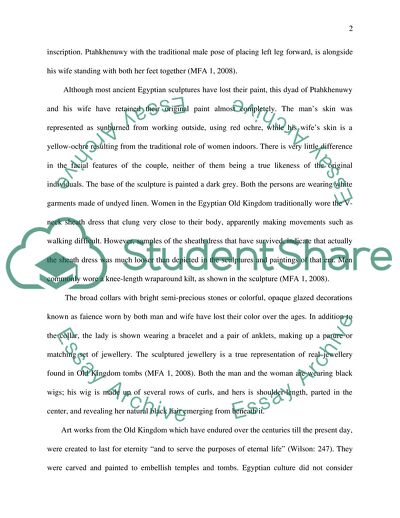
- Home
- Free Samples
- Premium Essays
- Editing Services
- Extra Tools
- Essay Writing Help
- About Us
- Studentshare
- Subjects
- Miscellaneous
- Art history
Art history - Essay Example

- Subject: Miscellaneous
- Type: Essay
- Level: Undergraduate
- Pages: 4 (1000 words)
- Downloads: 0
- Author: pbosco
Extract of sample "Art history"
Ptahkhenuwy has been identified from the inscription at the base of the statues as the supervisor of palace retainers. His wife’s name is illegible in the faded inscription. Ptahkhenuwy with the traditional male pose of placing left leg forward, is alongside his wife standing with both her feet together (MFA 1, 2008). Although most ancient Egyptian sculptures have lost their paint, this dyad of Ptahkhenuwy and his wife have retained their original paint almost completely. The man’s skin was represented as sunburned from working outside, using red ochre, while his wife’s skin is a yellow-ochre resulting from the traditional role of women indoors.
There is very little difference in the facial features of the couple, neither of them being a true likeness of the original individuals. The base of the sculpture is painted a dark grey. Both the persons are wearing white garments made of undyed linen. Women in the Egyptian Old Kingdom traditionally wore the V-neck sheath dress that clung very close to their body, apparently making movements such as walking difficult. However, samples of the sheath dress that have survived, indicate that actually the sheath dress was much looser than depicted in the sculptures and paintings of that era.
Men commonly wore a knee-length wraparound kilt, as shown in the sculpture (MFA 1, 2008). The broad collars with bright semi-precious stones or colorful, opaque glazed decorations known as faience worn by both man and wife have lost their color over the ages. In addition to the collar, the lady is shown wearing a bracelet and a pair of anklets, making up a parure or matching set of jewellery. The sculptured jewellery is a true representation of real jewellery found in Old Kingdom tombs (MFA 1, 2008).
Both the man and the woman are wearing black wigs; his wig is made up of several rows of curls, and hers
...Download file to see next pages Read MoreCHECK THESE SAMPLES OF Art history
Art History Paper
19th art history, urban
Art History - Tracey Emin
Art History Project
Art History - Renaissance Period
East Asian Art History
Art History - Van Gogh
Islamic Art history

- TERMS & CONDITIONS
- PRIVACY POLICY
- COOKIES POLICY